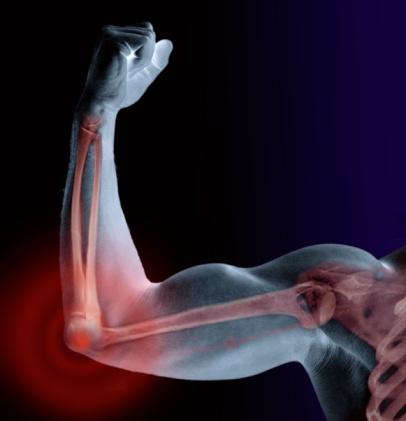
Arthritis isn't just one disease, but a complex disorder comprised of more than 100 distinct conditions that can affect people at any stage of life. Two of the most common forms are osteoarthritis and rheumatoid arthritis. While these two forms of arthritis have very different causes, risk factors and effects on the body, they often share a common symptom—persistent joint pain.
For many people, arthritis pain and inflammation cannot be avoided as the body ages. In fact, most people over the age of 50 show some signs of arthritis as joints naturally degenerate over time. Fortunately, arthritis can often be managed with acupuncture and Oriental medicine.

Osteoarthritis is the most common form of arthritis, affecting an estimated 21 million adults in the United States. Beginning with the breakdown of joint cartilage that results in pain and stiffness, osteoarthritis commonly affects the joints of the fingers, knees, hips, and spine. Other joints affected less frequently include the wrists, elbows, shoulders, and ankles. When osteoarthritis is found in a less frequently affected joint, there is usually a history of injury or unusual stress to that joint. Work-related repetitive injury and physical trauma may contribute to the development of osteoarthritis. If you have a strenuous job that requires repetitive bending, kneeling or squatting, for example, you may be at high risk for osteoarthritis of the knee.
Rheumatoid arthritis can affect many different joints and, in some people, other parts of the body as well, including the blood, lungs, and heart. With this form of arthritis, inflammation of the joint lining, called the synovium, can cause pain, stiffness, swelling, warmth, and redness. The affected joint may also lose its shape, resulting in loss of normal movement. Rheumatoid arthritis can last a long time and is a disease characterized by flares (active symptoms) and remissions (few to no symptoms).
According to Oriental medical theory, arthritis arises when the cyclical flow of Qi (energy) in the meridians becomes blocked resulting in pain, soreness, numbness, and stiffness. This blockage is called "bi syndrome" and is associated with "bi" type pain. It is widely studied and successfully treated using a combination of treatment modalities. The acupuncture points and herbs that are used depending on whether the underlying cause of the blockage of Qi(arthritis) is caused by wind, cold, damp or damp-heat.
Acupuncture and Oriental medicine aim to treat the specific symptoms that are unique to each individual using a variety of techniques such as acupuncture, bodywork, lifestyle/dietary recommendations and energetic exercises to restore imbalances found in the body. Therefore, if 10 patients are treated with Oriental medicine for joint pain, each of these 10 patients will receive a unique, customized treatment with different acupuncture points, different herbs/supplements and different lifestyle and diet recommendations.
Your acupuncturist will examine you, take a look at the onset of your condition and learn your signs and symptoms to determine your diagnosis and choose the appropriate acupuncture points and treatment plan.

Regular physical activity helps build and maintain healthy bones, muscles and joints. Tai Chi, a Chinese exercise that strengthens muscles, improves balance and flexibility, promotes relaxation, and has been shown to relieve chronic joint pain.
Maintaining an appropriate weight or reducing weight to a recommended level reduces the risk of osteoarthritis. Losing just 10 pounds relieves 40 pounds of pressure on knees. For those living with symptoms, losing 15 pounds can cut knee pain in half.
Try to modify your movements, since repeated use of joints in jobs that require bending and lifting is associated with an increased risk of developing osteoarthritis.
Speak with a healthcare professional about ways to reduce strain on your joints.
A balanced, varied diet can help ease the pain of arthritis by providing vitamins and minerals that keep your joints healthy. Avoiding “damp” foods such as dairy products and greasy or spicy foods also helps joints.
Ginger is a natural anti-inflammatory. A fresh ginger tea can be made by combining a half teaspoon of grated ginger with 8 ounces of boiling water. Cover and steep for 10 to 15 minutes, strain and add honey to taste.
Bromelain, an enzyme in pineapple, reduces inflammation. Be sure the pineapple is fresh, not canned or frozen.
Recent research has shown that tart cherries are an excellent source of nutrients that may help to reduce joint pain and inflammation related to arthritis.
Cold-water fish such as salmon and mackerel contain omega-3 fatty acids, which help keep joints healthy as well as reduce pain and swelling.
A natural anti-inflammatory, it can be used in many food preparations including soups, sauces, and salad dressings.

Several studies have shown that acupuncture can help people with arthritis and related auto-immune diseases.
Scientists found that acupuncture can reduce pain and improve mobility in arthritis patients by 40 percent based on results from a major clinical trial that investigated the ancient Chinese needle treatment. A total of 570 patients aged 50 and older with osteoarthritis of the knee took part in the American study. All had suffered significant pain in their knee the month before joining the trial but had never experienced acupuncture. By the eighth week, patients receiving genuine acupuncture treatments showed a significant increase in function compared with both the "placebo" treatment and self-help groups. By week 14, they were also experiencing a significant decrease in pain.
In a German study, 3,500 people with osteoarthritis of the hip and/or knee received 15 sessions of acupuncture combined with their usual medical care. The results showed that the patients that received acupuncture had less pain and stiffness, improved joint function and better quality of life than their counterparts who had routine care alone. The improvements occurred immediately after completing a three-month course of acupuncture and lasted for at least another three months, indicating osteoarthritis is among conditions effectively treated with acupuncture.
Another study, published in the journal Pain, looked at the effects of acupuncture among 40 adults with osteoarthritis of the knee. Among the patients in the study, those who had a daily acupuncture session for 10 consecutive days reported greater improvement in their pain compared with patients who received a "placebo" version of the therapy.
In one Scandinavian study, 25 percent of arthritis patients who had been scheduled for knee surgery cancelled their operations after acupuncture treatment. In the study, researchers compared acupuncture with advice and exercise for the treatment of osteoarthritis of the hip.
Thirty-two patients awaiting a total hip replacement were separated into two groups. One group received one 10-minute and five 25-minute sessions of acupuncture, and the other group received advice and hip exercises over a 6-week period. Patients were assessed for pain and functional ability: Patients in the acupuncture group showed significant improvements, while no significant changes were reported in the group that received advice and exercise therapy. The results of this study indicate that acupuncture is more effective than advice and exercise for the treatment of osteoarthritis of the hip.
A University of Maryland School of Medicine study showed that elderly arthritis patients with knee pain due to arthritis improved significantly when acupuncture was added to their treatment. The randomized clinical trial determined whether acupuncture was a clinically safe and effective adjunctive therapy for older patients with osteoarthritis of the knee. The study addressed the addition of acupuncture to conventional therapy to determine if it would provide an added measure of pain relief, if the effects would last beyond treatment and if treatment would have any side effects. Seventy-three patients were randomly divided into two groups. One group received twice-weekly acupuncture treatments and conventional therapy for eight weeks, and the other group received conventional therapy only. Patients who received acupuncture had significant pain relief and showed improvement in function. Those who did not receive acupuncture showed no significant change. No patients reported negative side effects from any acupuncture therapy session.
For more information, please visit: www.moveyourQi.com or write to:
Anna Dolopo, M.T.O.M., L.Ac.
Elements in Harmony Acupuncture & Chinese Herbs
23151 Verdugo Drive, Suite 114
